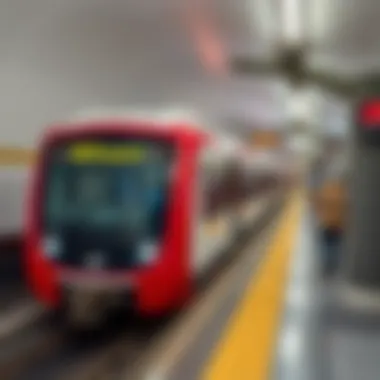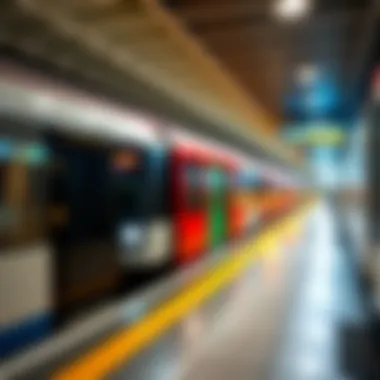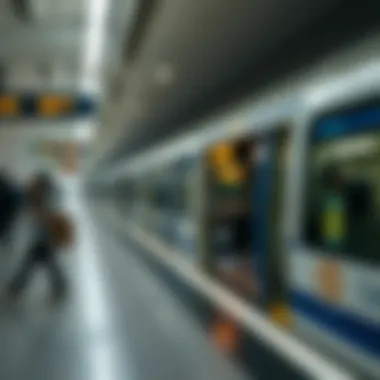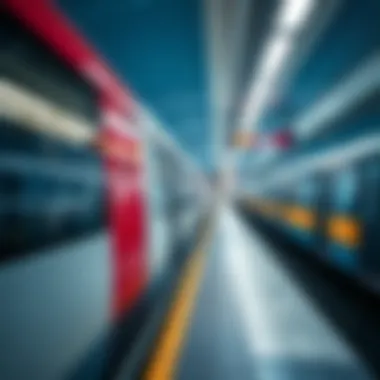Dubai Metro Saturday Timings Explained for Commuters


Intro
Navigating the vibrant city of Dubai can be nothing short of an adventure. The Dubai Metro has become a lifeline for many commuters, offering a convenient and efficient mode of transport. Particularly on Saturdays, understanding how the Metro operates is crucial for effective travel planning.
The Metro’s operational schedule carries implications not only for day-to-day commuters but also for those considering property investment and long-term living arrangements in Dubai. Recognizing the Metro's timings can play a significant role in enhancing one's commuting experience and, by extension, overall lifestyle in this dynamic city.
This article aims to delve into the nitty-gritty of the Dubai Metro's Saturday service, highlighting essential timings, routes available, and the broader effects on the region's transport landscape. With this knowledge in hand, commuters, residents, and visitors alike can navigate the Metro like seasoned pros.
Prolusion to Dubai Metro
The Dubai Metro stands as a critical component of Dubai's transportation ecosystem, weaving seamlessly through the fabric of the city. It embodies modernity and efficiency, catering to the bustling lifestyle of locals and tourists. With each passing year, the significance of understanding its operational timings, especially on Saturdays, becomes more pronounced. Saturdays, typically seen as a bridge between the workweek and the weekend, reveal a unique dimension in the way the Metro operates, catering to different passenger needs.
Understanding the Metro system is essential for anyone looking to navigate Dubai smoothly. This article delves into the intricate details of Saturday Metro timings, giving readers a grasp on how these schedules impact commuting choices. From pinpointing the busiest routes to recognizing off-peak hours, every tidbit of information serves an important purpose for residents and visitors alike.
Overview of the Dubai Metro Network
The Dubai Metro network is a marvel of urban planning. Spanning 89 kilometers, it connects key districts, shopping areas, and residential neighborhoods. Operating since 2009, the Metro features two primary lines: the Red Line and the Green Line. The stunning architecture of its stations, designed with a fusion of traditional Arab elements and futuristic design, creates an inviting first impression for visitors.
Key Features:
- Fully Automated: The Metro operates without drivers, showcasing the city's commitment to cutting-edge technology.
- Key Stations: Notable stations like Burj Khalifa/Dubai Mall and Dubai Marina ensure tourists can visit major attractions easily.
While the network is critical for daily commuters, its importance is heightened on Saturdays. The weekend crowd varies significantly from other days, as many are on leisure trips rather than work commutes. This shift necessitates a different operational tempo, where understanding the flow becomes handy for both planning trips and avoiding long waits.
Importance of Public Transportation in Dubai
Public transportation is a linchpin in Dubai's bustling environment. With a population that happily flocks to the city from every corner of the globe, the growing demand for efficient transport solutions continues to rise. Metro systems like Dubai's serve practical purposes, alleviating traffic congestion while promoting sustainable travel options.
Here are several reasons why public transport matters:
- Accessibility: Providing a well-connected system increases accessibility for all, from tourists exploring the attractions to professionals heading to meetings.
- Environmental Impact: By encouraging less use of personal vehicles, public transport mitigates pollution and supports the city’s sustainability goals.
- Economic Growth: Efficient transport systems aid in boosting local businesses, as customers can reach them more easily by transit.
As Dubai embraces its status as a global hub, the Metro exemplifies this shift towards modern public transportation. Understanding how it operates on Saturdays, in particular, helps to appreciate its role in both day-to-day commutes as well as weekend leisure activities.
"A well-planned transport system is like the bloodstream of a city; it nourishes every corner, empowering growth and enhancing quality of life."
Ultimately, the Dubai Metro is more than just a means of transport; it’s an investment in the city’s future, making it crucial to understand its workings. Those with an eye on the property market, business expansions, or travel planning must consider the effect of Metro timings and routes on overall accessibility and urban development.
Typical Saturday Operations
Understanding the typical operations of the Dubai Metro on Saturdays is essential for commuters, residents, and visitors alike. As a major backbone of public transport in Dubai, the Metro operates on a schedule that accommodates varied needs throughout the week, with Saturdays holding particular significance for leisure activities, shopping sprees, and general travel across the city. During this day, families, holidaymakers, and working professionals utilize the service differently compared to weekdays, affecting not only their travel plans but also the overall dynamics of the transit system.
Standard Operating Hours on Saturdays
On Saturdays, the Dubai Metro has set operating hours that cater to both early risers and late-night adventurers. The usual operational hours start at 5 AM and end at midnight. This schedule allows commuters ample time to travel for leisure or errands, especially since many businesses and shopping centers operate on weekends.
More specifically:
- Red Line: Typically runs from 5:00 AM to 12:00 AM, ensuring coverage for the bustling areas of Dubai that attract many weekend visitors.
- Green Line: Follows similar timings, also operating from 5:00 AM to 12:00 AM.
Trains generally run every 7-8 minutes during the day, but it’s advisable to check the RTA app or website for any immediate updates on delays or changes in service.
Variations During Holidays or Events
It's crucial to note that during public holidays or special events, the Metro's timings may see alterations. For instance, during the Eid celebrations or the Dubai Shopping Festival, specific hours may be extended to accommodate the surge in passengers. People flock in droves to shopping malls hosting promotions and entertainment.
For example:
- Eid Al Fitr: Increased operating hours might push the end of service to 1 AM, catering to those celebrating the festive occasion by going out late into the night.
- National Day: The Metro may see altered schedules to manage the large crowds attending parades and festivities.
Always keep an eye on the official Dubai Metro channels for real-time updates during such occasions. The efficient management of Metro operations during peak times and holidays significantly enhances the overall commuting experience.
Tip: Consider using the NOL card for seamless travel across the Metro, especially on busy weekends.
Successful navigation of the Dubai Metro on Saturdays not only enhances travel efficiency but also enriches your overall experience in the vibrant city of Dubai.
Key Metro Lines and Stations
The Dubai Metro is a vital component of the city’s public transport infrastructure. Understanding the key lines and stations becomes crucial for anyone navigating this sprawling metropolis, whether they are homebuyers, investors, real estate agents, expatriates, or property managers. The Metro connects various neighborhoods and business hubs, fostering convenience and accessibility. This connectivity not only supports daily commuters but also influences property values in proximity to stations.
Red Line Services and Timings


The Red Line is the backbone of the Dubai Metro, stretching over 52 kilometers. It serves a slew of essential areas, including popular destinations like Dubai Mall and the Dubai Financial Centre. On Saturdays, the service usually kicks off at 5:00 AM, running until midnight. Each train comes at regular intervals, approximately every 7-10 minutes during peak hours and around 15 minutes during quieter times.
Key Stations on the Red Line:
- Burj Khalifa/Dubai Mall: This station is the gateway to one of the world’s most famous landmarks, making it a hub for tourists.
- Dubai Marina: A lively area known for its dining and nightlife options, this station connects residents and visitors to a vibrant neighborhood.
- Deira City Centre: One of Red Line's major interchange stations, facilitating easy transfers to bus services.
Whether someone is shopping, dining, or commuting for work, using the Red Line makes the journey seamless and efficient.
Green Line Services and Timings
The Green Line may not be as long as the Red Line, but it covers some of Dubai’s oldest districts, offering travelers a taste of the city’s rich heritage. Operating on Saturdays, the Green Line starts at 5:30 AM and also runs until midnight, with trains departing every 5-10 minutes during busy hours and 15 minutes at off-peak times.
Key Stations on the Green Line:
- Al Fahidi: Often praised for its proximity to the historic Al Bastakiya quarter, this station allows passengers to step back in time and experience the cultural side of Dubai.
- Dubai Healthcare City: Vital for residents and employees in the medical profession, offering a direct link to health services.
- Union: A critical junction that connects to the Red Line, making interchanges straightforward and hassle-free.
The Green Line plays a significant role by connecting commuters to economic sectors and residential neighborhoods, thereby influencing urban development in these areas.
In summary, both the Red Line and the Green Line are indispensable for navigating Dubai. They not only serve commuters but also enrich the urban landscape, contributing to the overall growth and connectivity of the city.
"Public transport is not just about moving people; it's about shaping their experience of the city."
For more details on the metro system, you can visit RTA's Official Website or look up the geographical information at Wikipedia - Dubai Metro.
Fares and Ticketing
Understanding the fare system and ticketing process of the Dubai Metro is crucial for a seamless travel experience. Since it connects multiple parts of this vibrant city, knowing how much it costs and how to get tickets can save time and potential frustration for passengers. This section aims to dissect the fare structure, provide clarity on purchasing tickets, and ultimately highlight the benefits of using the Dubai Metro for both commuters and visitors.
Understanding Dubai Metro Fare Structure
Dubai’s Metro fare system is designed to accommodate a variety of passenger needs, making it accessible and straightforward. The fare structure is based on a distance-based model, where ticket prices vary depending on how far you travel. Here’s the breakdown:
- All Zones: Commuters within the same zone pay a set fare, while those traveling across multiple zones incur additional charges.
- Fare Range: Typically, a single journey can cost anywhere from AED 3 to AED 8.50, depending on the zones crossed.
- Nol Cards: Using a Nol Card is highly recommended for anyone planning to frequently travel on the Metro. This rechargeable smart card allows you to save on fares and is valid across all public transport modes.
Moreover, there are different types of Nol Cards:
- Silver Card: Suitable for regular users, it has a one-time purchase fee plus the recharge amount.
- Gold Card: Offers all the benefits of the Silver Card but provides first-class access for those preferring a more luxurious travel experience.
- Red Ticket: Ideal for occasional travelers, the Red Ticket allows for up to ten trips.
The flexibility of the Dubai Metro fare system promotes public transport use, which is vital for reducing traffic congestion in the growing city.
How to Purchase Tickets
Purchasing tickets for the Dubai Metro is a hassle-free process. You can choose between buying a Nol Card or a single journey ticket. Below are the ways to secure your ticket:
- At Metro Stations:
- Online:
- Kiosks and Retail Outlets:
- Simply head to the ticket vending machines available at each metro station. These machines accept both cash and card payments and provide instructions in multiple languages, catering to the diverse expat community.
- You can also purchase Nol Cards or recharge existing ones online through the official RTA website or mobile app, allowing you to plan ahead and avoid any last-minute rush.
- Select retail outlets across Dubai also sell Nol Cards. This can be convenient if you happen to be out and about and want to get your travel organized.
Benefits of Efficient Ticketing
Using the Dubai Metro not only ensures reliable transportation but also helps in managing travel costs efficiently. Some highlights include:
- Time-saving: Quick access without needing to queue for tickets at stations.
- Cost-Effective: Regular use of the Metro can lead to significant savings compared to taxi fares.
- Ease of Use: Automated systems and user-friendly devices make it easy for anyone to navigate the ticketing process, regardless of their language proficiency.
In summary, understanding the fare structure, knowing how to purchase tickets, and making the right choice between different types of Nol Cards can greatly enhance your experience with the Dubai Metro. Familiarity with these elements allows commuters, expats, and tourists to effectively utilize the Metro for their travel needs throughout Dubai.
Navigating the System
Navigating the Dubai Metro system is crucial for anyone looking to optimize their commuting experience. Given the expanse of this network, understanding how to traverse the various lines can make a huge difference in one's travel time and ease. Whether you're a resident trying to cut your daily commute or a visitor wanting to explore the city without the hassle of driving, knowing the ins and outs of the Metro system is essential. It is not just a mode of transport; it's a key element in engaging with what Dubai has to offer.
Metro Maps and Resources
One of the most helpful assets in navigating the system is the availability of Metro maps and various other resources. These are more than just colorful representations of the routes;
- Interactive Maps: Some mobile applications provide real-time updates on train timings and delays, which can be invaluable during peak hours or unexpected service changes.
- Printed Maps: Located at every station, these maps offer a straightforward view of lines and stops, ideal for those who prefer a physical reference over a smartphone screen.
- Online Resources: Websites such as RTA Dubai offer comprehensive information about service schedules, ticket types, and other essential details.
Having access to up-to-date and clear maps is pivotal for efficient use of the Metro, especially for individuals unfamiliar with the area.


Tips for Efficient Travel
To make the most of your time on the Dubai Metro, consider the following tips:
- Plan Ahead: Familiarize yourself with the Metro schedule and map via the RTA app or website before traveling. This can help cut down time spent waiting on platforms.
- Peak Hours: The trains can get packed during rush hours, particularly in the mornings from 7 AM to 9 AM and evenings from 5 PM to 8 PM. If you can, try to travel outside these times.
- Mind the Rules: The Metro is known for its regulations. Be mindful of designated carriages for families and women, as well as avoid eating and drinking on the train.
- Know the Stations: Understanding where to get off can enhance your travel experience. Many stations are connected to shopping malls, tourist attractions, and other public transport options. This can make transitions smoother and provide added convenience.
Navigating the Metro system may seem overwhelming at first, but with the right tools and knowledge, it can quickly become intuitive. Engaging with the local transport network judiciously can save both time and effort, allowing for a better focus on what matters—the experience of living in or visiting vibrant Dubai.
"Public transport is not just about getting from point A to point B; it's about integrating yourself into the fabric of the city."
f By embracing the resources available and following a few best practices, you’ll find the Metro is not merely a transportation service but a bridge to experiences across Dubai.
Connections to Other Transport Services
In a bustling metropolis like Dubai, the integration between various modes of transport is pivotal to ensuring seamless urban mobility. The connection of the Dubai Metro to other transportation services significantly enhances the travel experience for both residents and visitors. From bus services to ride-sharing options, the synergy among these systems permits efficient movement throughout the city, which is particularly advantageous on busy Saturdays when many partake in weekend outings or activities.
Integration with Bus Services
The collaboration between Dubai Metro and bus services creates a comprehensive transport network. Buses operate in a synchronized schedule with the Metro, allowing commuters to transfer effortlessly from one mode to another. For instance, upon riding the Red or Green Line, users can easily hop on a bus to extend their journey to destinations beyond the Metro’s reach. This is particularly beneficial for those in suburbs or areas lacking direct access to the Metro.
Moreover, the RTA's (Roads and Transport Authority) bus system complements the Metro in a few crucial ways:
- Coverage: The bus network boasts extensive reach in Dubai, covering areas that may not be directly accessible via the Metro.
- Scheduled Transfers: Timetables are coordinated to minimize waiting times, facilitating a smoother transfer experience.
- Unified Fare System: Passengers can use a single Nol card for both Metro and bus rides, simplifying the ticketing process and reducing the hassle of multiple fare payments.
This integrated approach ensures that commuters can navigate the metro area efficiently, providing a practical solution for those with varying travel needs.
Access to Taxis and Ride-Sharing
Access to taxis and ride-sharing platforms like Careem and Uber further enhances the connectivity of Dubai Metro. Upon disembarking at any Metro station, commuters have immediate access to convenient ground transport options. This flexibility enhances the overall efficacy of public transport in Dubai. Riders can easily catch a taxi or request a ride-share, getting them to their final destination without the concern of parking or traffic.
The importance of these services includes:
- Last-Mile Connectivity: For those who need to travel the final leg to their destination, taxis and ride-sharing fill in the gaps that public transport may not cover.
- 24/7 Availability: Taxis are available at all hours, making them a reliable option even late at night when Metro services cease.
- User-friendly Technology: Most ride-sharing apps integrate user-friendly technology, making it simple for passengers to find a ride, track their driver, and pay with ease.
"The convenience of public transport in Dubai is heavily reliant on the seamless integration with services like buses and taxis, creating a robust commuting infrastructure."
For more related information, visit RTA Dubai or check out community insights on platforms like Reddit.
They provide further details and real-time feedback that can help navigate your journey effectively.
Commuter Insights and Experiences
Navigating the Dubai Metro isn’t just about catching the next train; it encompasses the experiences and insights of those who rely on it daily. Regular commuters provide a unique lens into how effectively the system operates. Their accounts unveil a wealth of knowledge that can assist both potential users and current patrons. When we look at the commutes of these individuals, several key elements emerge, showcasing the importance of understanding their feedback.
- Pattern Recognition: Commuters highlight not only the timing but also the behavioral patterns that arise. For example, Saturday mornings tend to be quieter, allowing for a more relaxed ride compared to weekdays when the trains are often packed. This insight can help visitors choose optimal times for travel.
- Service Consistency: Regular riders emphasize the consistency of service. The punctuality of the Metro is often cited as a primary factor in their satisfaction. Knowing the likelihood of trains running late can be a deciding point for those weighing public transport options against alternatives like taxis.
The voices of these daily travelers contribute to a collective understanding of the Metro’s impact on the broader commute landscape in Dubai.
Feedback from Regular Commuters
Feedback from regular commuters is crucial in painting a vivid picture of the Metro experience on Saturdays. Many express appreciation for the overall cleanliness and functionality of the stations, while also offering constructive criticism regarding peak times.
For instance, some have noted,
"While I often admire the aesthetics of the stations, during particular hours, it feels like sardines in a can. But I usually plan my trips just outside these busy windows."
Here we see that commuters often adapt strategies based on their observations to ensure a smoother travel experience.
- Positive Aspects:
- Areas for Improvement:
- Cleanliness of the trains and stations
- Availability of announcements in multiple languages
- Helpful staff presence during peak hours
- More frequent services during specific busy times
- Additional signage for first-time users,
- More seating during off-peak hours in key areas
Such feedback not only highlights user satisfaction but also reveals areas where enhancements can be made, indicating that the Metro system is receptive to change.
Visitor Perspectives on the Metro
Visitors to Dubai often have varied perspectives on the Metro, shaped by their experiences in other cities around the globe. Many visitors express surprise at how the Metro operates seamlessly within the city, facilitating easy travel between major attractions. Feedback from these visitors often includes a mix of awe and appreciation regarding the efficiency of the transport system.
A common sentiment shared is,


"I was genuinely impressed, it felt like I could get to any corner of Dubai, all without the hassle of traffic."
Edifying insights from visitors include:
- Ease of Access: Many newcomers find the Metro intuitive, although a few suggest that greater orientation resources could be helpful, particularly in key tourist spots.
- Affordability: Visitors frequently rave about the cost-effectiveness of using public transport. In a city where luxurious living is common, the Metro offers an economical way to experience Dubai.
- Connectivity: A notable point raised by travelers is the integration of the Metro with various services, including buses and taxis, allowing for seamless transfers between modes of transport.
Thus, the insights and experiences captured from both regular commuters and visitors create a multi-faceted view of the Dubai Metro, revealing that while improvements can always be made, the system holds immense value for both residents and guests alike.
Metro-Linked Real Estate Insights
The relationship between the Dubai Metro and real estate is substantial, not just for investors but also for homebuyers and expatriates seeking a harmonious lifestyle in this bustling metropolis. As the Metro network expands, it's becoming increasingly important to examine how proximity to stations affects property values and investment trends.
Impact on Property Values Near Stations
One of the more tangible benefits of the Metro's growth is its impact on property values. When you look at areas that boast easy access to metro stations, there’s often a marked increase in property prices. This is primarily because many buyers and renters prioritize convenience, and nothing says convenience quite like being just a hop away from a train that links you to various districts in Dubai.
Consider neighborhoods such as Dubai Marina or Jumeirah Lakes Towers. Properties in these areas are often priced higher than those further away from metro stations. Not only do these locations offer desirable amenities and scenic views, but their proximity to the Metro also significantly enhances their appeal. Investors looking to secure a profitable property should keep an eye on such regions.
"Access to the Metro serves as a modern-day gold star for property value appreciation, attracting buyers like moths to a flame."
For those considering luxury apartments or commercial spaces, understanding this trend can be a game changer. The increase in foot traffic from commuters leads to potential rental price hikes, making property investments close to metro lines more lucrative in the long run.
Trends in Dubai Property Investment
The integration of a robust public transport system like the Dubai Metro plays a fundamental role in shaping investment trends. Investors are increasingly seeing metro-linked properties as a safe bet, especially as Dubai continues to promote public transport as a viable alternative to personal vehicles.
Visiting the bustling neighborhoods connected by the Metro reveals a dynamic landscape of real estate opportunities.
- Affordability: Smaller, more affordable homes near metro stations are gaining traction, attracting young professionals and families who prioritize convenience without breaking the bank.
- Commercial Potential: Areas adjacent to metro stations have attracted not only housing developments but also retail and office spaces. Entrepreneurs see the potential for high customer footfall in these locations.
- Long-term Investments: With the ongoing expansions in metro rail, savvy investors are focusing on property near upcoming stations, anticipating a spike in real estate appreciation once these services are operational.
The benefits of investment in Dubai's real estate market, particularly properties close to the Metro, cannot be overstated. Buyers and investors should keep abreast of developments within the Metro system to align their property choices with broader urban planning initiatives, ensuring they’re not just chasing trends but investing wisely for the future.
Investing in real estate tied to the Metro not only promotes sustainable living but also supports the overall urban growth of Dubai—a city constantly evolving to meet the needs of its residents.
Future Developments in Metro Services
The evolution of the Dubai Metro system is pivotal in shaping the city's transportation landscape. Through thoughtful planning and strategic investments, these future developments promise to enhance connectivity, reduce traffic congestion, and cater to the growing population. Understanding the timeline and scope of these improvements is essential for commuters and property investors alike, as accessibility remains a key factor influencing real estate trends in this bustling metropolis.
Upcoming Stations and Extensions
As part of Dubai's ambitious plans, several new stations are on the horizon. These upcoming stations aim to bring the Metro even closer to residential and commercial hubs. Here are some notable projects:
- The Purple Line: This extension will connect key areas that currently lack direct Metro access, significantly enhancing travel for both residents and tourists.
- Jumeirah Station: Set to cater to the upscale neighborhoods, this station is designed to support the growing demand from residents and businesses.
- Academic City Station: In response to the education sector's expansion, this station will serve students and faculty, connecting them effortlessly to the city’s other transport nodes.
These expansions are not just about adding tracks. They reflect a broader strategy aimed at improving urban mobility. As the city grows, so does the need for a reliable transport system that can accommodate more riders while remaining efficient.
Innovations in Transportation Technology
With advancements in technology, the Dubai Metro is poised to incorporate cutting-edge solutions that will not only streamline operations but also enhance user experience. Key innovations include:
- Real-Time Tracking Systems: Commuters will soon enjoy real-time updates on train arrivals, enabling better planning and reducing wait times.
- Contactless Payment Solutions: Future enhancements will include integrating mobile payment methods, making it easier for users to access services without fumbling for cash or cards.
- Smart Station Facilities: Proposed upgrades include interactive kiosks, enhanced Wi-Fi connectivity, and improved safety measures, all designed to make commuting more convenient.
These innovative approaches aim to attract a wider audience and make the Metro system even more competitive as a travel option compared to private vehicles. As the Dubai Metro continues to grow with the urban landscape, public transportation's role in enriching the city's infrastructure cannot be overstated.
"Innovation is the heartbeat of a thriving city like Dubai, shaping not just how we travel, but how we connect with others and grow together."
End
Understanding the operational timings of the Dubai Metro on Saturdays is vital for everyone who relies on this essential transport system in the city. This day of the week often sees a diverse mix of commuters, from residents heading to work or leisure activities to tourists exploring the dynamic urban landscape of Dubai. As such, grasping the nuances of the schedule can not only enhance individual travel experiences but also better inform broader regional transport strategies.
Summary of Key Points
Within this article, we have delved into several key aspects:
- Saturday Operating Hours: Detailed insight into standard operational timings, ensuring that commuters know when to plan their travels.
- Variations for Holidays and Events: Recognition of how special days might affect operations, preparing travelers for potential changes in schedule.
- Key Services Offered: An overview of the Red and Green lines, including peak service intervals and station highlights, which are crucial for effective route planning.
- Fares and Ticketing: Clarifying the fare structure and providing clear methods on how to purchase tickets, which is indispensable for first-time and regular users alike.
- Connections with Other Transportation: Understanding how the metro integrates with buses and other forms of transport helps in creating seamless travel experiences.
These components collectively illustrate not just the mechanics of the Metro but also its significance in the overall structure of Dubai's public transport system. The metro isn’t merely a means of getting from point A to B; it serves as a lifeline connecting communities and promoting accessibility throughout the thriving emirate.
The Role of the Metro in Dubai's Urban Landscape
The Dubai Metro has firmly established itself as a cornerstone of urban mobility in the city. With its efficient and reliable services, it actively contributes to reducing road congestion, which is crucial for a bustling metropolis that sees millions of inhabitants and visitors.
Moreover, the metro fosters regional development by enhancing accessibility to key commercial and residential areas. Properties near metro stations often see a significant uptick in market values as potential homeowners and investors recognize the convenience of having rapid transit options nearby. This connection between transport infrastructure and real estate appreciation cannot be overstated.
Additionally, the Dubai Metro embodies an eco-friendly approach to urban transport. By promoting usage over personal vehicles, it helps to lower carbon emissions, aligning with Dubai's sustainability goals. Embracing this mode of travel supports a vision of a smart and sustainable city, enhancing the overall quality of life for its residents.
In light of this, the metro's role is both comprehensive and impactful, serving not only to facilitate day-to-day journeys but also shaping the possibilities of urban planning for the future.



